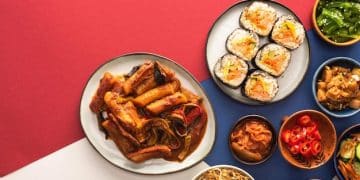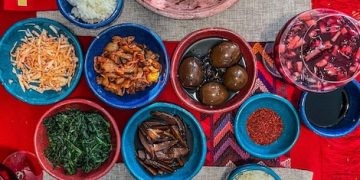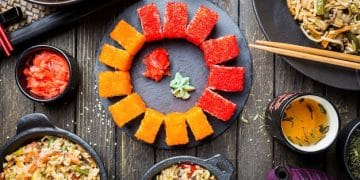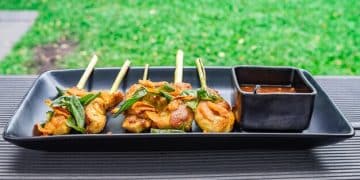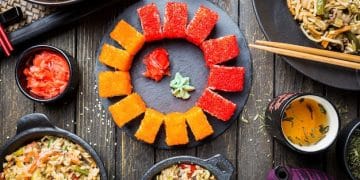Korean cuisine cultural guide: explore rich traditions

Korean cuisine is characterized by its diversity of flavors, vibrant dishes, and cultural significance, with regional variations showcasing the unique ingredients and culinary practices that reflect the rich heritage of Korea.
Korean cuisine cultural guide invites you to discover vibrant flavors and traditions. Have you ever wondered what makes these dishes so special? Let’s explore together.
Introduction to Korean cuisine
Introduction to Korean cuisine offers a glimpse into a world rich with flavors and cultural significance. The unique combinations of ingredients and cooking techniques make it a delightful experience for food lovers. Let’s dive deeper into the essentials that define this cuisine.
Core Elements of Korean Cooking
At the heart of Korean cuisine are fresh ingredients and time-honored cooking methods. Key elements like rice, vegetables, and meats are often combined with various seasonings to create memorable dishes. Here are some core components:
- Kimchi: A staple side dish made from fermented vegetables, usually napa cabbage and radishes, packed with flavor.
- Rice: The foundation of most meals, often served with a variety of side dishes.
- Spices and Sauces: Ingredients like gochujang (red chili paste) and doenjang (fermented soybean paste) add depth and unique flavors.
Cultural Significance
Korean meals are not just about food; they are expressions of culture and community. It’s common to share dishes among diners, enhancing the experience of togetherness. The act of eating is as much about maintaining relationships as it is about satisfying hunger. Family gatherings often revolve around elaborate spreads that reflect love and social bonds.
Regional variations also play a significant role in Korean cuisine. Each area boasts its own specialties, influenced by local ingredients and traditions. For example, the coastal regions highlight seafood and spicy stews, while the inland areas may focus on heartier meat dishes. This diversity makes Korean food a vibrant tapestry of flavors that excites the palate.
Core ingredients of Korean dishes

The core ingredients of Korean dishes play a crucial role in creating the unique flavors that define this vibrant cuisine. Understanding these components helps in appreciating the depth and variety found in Korean cooking.
Essential Ingredients
Many Korean dishes rely on fresh and simple ingredients that showcase the natural flavors of food. Each ingredient brings its unique character to the table. Here are some essential ingredients:
- Rice: A staple in Korean meals, it is often served as the base for various dishes.
- Kimchi: Fermented vegetables that provide a spicy and tangy flavor, essential to many meals.
- Tofu: Versatile and protein-rich, tofu is used in stews and stir-fries.
Fermented products also hold significant importance in Korean cuisine. For instance, doenjang and gochujang are fermented soybean paste and chili paste, respectively, that add depth and complexity to dishes.
Moreover, vegetables are central to Korean cooking. Ingredients such as spinach, radishes, and beansprouts are commonly used, not only for flavor but also for nutrition. These ingredients are often prepared simply to retain their freshness and nutrients, accentuating the essence of each dish.
Flavor Enhancers
Furthermore, flavor enhancers like sesame oil and garlic add richness to the cuisine. Sesame oil is frequently drizzled over dishes for a nutty flavor, while garlic is another key ingredient, known for its aromatic qualities.
The balance of flavors is crucial, and the skillful use of these core ingredients demonstrates the artistry in Korean cooking. As you explore the recipes, remember that these elements work together, creating a delicious harmony that defines Korean cuisine.
Cultural significance of meals in Korea
The cultural significance of meals in Korea goes beyond just nourishment. Food is a vital part of social interaction and expressions of respect and love. Meals are often shared among family and friends, creating a sense of connection.
Sharing and Bonding
In Korean culture, sharing food symbolizes unity. Dining is often a communal experience. Families gather around the table for meals, encouraging conversation and togetherness. This bonding ritual strengthens family ties and fosters connections between friends. Meals are occasions where memories are made.
- Celebrations: Special occasions often feature elaborate meals, highlighting traditional dishes.
- Festivals: During holidays, families prepare special foods that have cultural meanings.
- Respect: Serving elders first is a way of honoring them during meals.
Traditional Practices
Traditional Korean meals usually consist of rice, soup, and several side dishes known as banchan. The variety reflects the abundance of nature and the importance of a balanced diet. Each dish is carefully prepared, ensuring flavors complement one another. This attention to detail showcases the importance of food preparation in expressing cultural values.
Certain dishes are tied to specific rituals, such as rice cakes during birthdays or tteokguk for New Year celebrations. These foods are not only delicious, but they also carry symbolic meanings, representing good fortune and health. It’s a way for Koreans to honor their heritage while enjoying the present moment around the dinner table.
Exploring regional variations in Korean food

Exploring regional variations in Korean food reveals the rich tapestry of flavors, ingredients, and cooking styles across different areas of Korea. Each region has its unique identity, shaped by local climate, history, and cultural influences.
Distinct Flavors by Region
In the southern regions, such as Jeolla-do, the food is known for its bold and rich flavors. The use of spices and varied ingredients creates a diverse culinary experience. This area is famous for dishes like bibimbap, which combines rice with vegetables, meat, and flavorful sauces.
- Jeolla-do: Rich flavors and abundant seafood dishes.
- Gyeongsang-do: Spicier dishes with a focus on grilled meats.
- Seoul: A mix of traditional and modern, featuring innovative interpretations of classic dishes.
Ingredients Influenced by Geography
The availability of fresh ingredients influences regional dishes. In coastal areas, seafood plays a crucial role. Popular dishes like hoe (sashimi) highlight the freshness of the catch.
Conversely, the mountainous regions utilize more hearty ingredients such as root vegetables and grains. This leads to the creation of comforting stews like kimchi jjigae, which warms the soul during colder months. Each dish tells a story of the land and culture, deeply rooted in tradition.
Culinary Festivals and Celebrations
Food festivals across Korea celebrate these regional specialties and promote cultural heritage. Events often showcase traditional cooking methods and local ingredients. Visitors can experience the vibrant atmosphere while tasting regional delicacies unique to each area. Festivals not only foster community spirit but also preserve culinary traditions for future generations.
By understanding the regional variations in Korean food, one gains insight into the deep cultural roots that shape the cuisine. The unique flavors, ingredients, and cooking practices reflect the history and lifestyle of the people. This rich diversity is what makes Korean cuisine so exciting and deserving of exploration.
FAQ – Frequently Asked Questions about Korean Cuisine
What are some essential ingredients in Korean cooking?
Essential ingredients include rice, kimchi, tofu, and various vegetables and spices that enhance flavor.
How does food play a role in Korean culture?
In Korean culture, sharing meals symbolizes unity and strengthens relationships among family and friends.
What are some popular regional dishes in Korea?
Popular dishes include bibimbap from Jeolla-do, spicy grilled meats from Gyeongsang-do, and fresh seafood from coastal regions.
Why is kimchi important in Korean cuisine?
Kimchi is a staple side dish that provides essential flavor and nutritional benefits, representing Korean culinary tradition.
